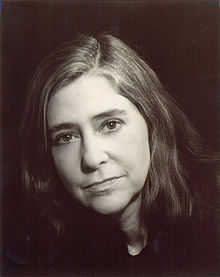- Margaret Hamilton (scientist)
-
Hamilton, Margaret 
Margaret Hamilton (1995 photo)Born 1938 Occupation Computer scientist and mathematician Margaret Hamilton (born 1938) is currently the founder and CEO of software development company Hamilton Technologies, Inc. However, she is best recognized for her role as an award-winning American NASA scientist and mathematician, who as Director of the Software Engineering Division of the MIT Instrumentation Laboratory (later the Charles Stark Draper Laboratory), played a key role in the success of the Apollo space program:[1] Margaret was responsible for helping pioneer the Apollo on-board guidance software required to navigate to/from and land on the moon, and its multiple variations used on numerous missions (including the subsequent Skylab).[1] Margaret was also the individual who coined the term “software engineering”.[2]
Dr. Paul Curto, senior technologist for NASA's inventions and contributions board noted her as having developed pioneering concepts of asynchronous software, priority scheduling, end-to-end testing, and man-in-the-loop decision capability, such as priority displays which then became the foundation for ultra reliable software design.[3] The surrounding contextual setting for her developments was one in which computer science and software engineering were not yet disciplines; instead learning was done on the job with hands on experience. Margaret rose through the ranks by gaining experience and contributing towards uncharted territory in space science.[1]
Her first award came in 1986 when she was awarded the Augusta Ada Lovelace Award by the Association of Women in Computing.[4] In 2003, she was granted a NASA Exceptional Space Act Award for her scientific and technical contributions and included with the award, Hamilton received a check for $37,200, the largest award to an individual in NASA's history. NASA Administrator Sean O'Keefe has commented saying “The concepts she and her team created became the building blocks for modern software engineering. It's an honor to recognize Ms. Hamilton for her extraordinary contributions to NASA.”.[3][5]
Contents
Research
As a NASA scientist, Margaret worked to gain hands-on experience during a time when computer science and software engineering courses or disciplines were non-existent. In the process, she produced innovations in the fields of system design and software development, enterprise and process modeling, preventative systems design, development paradigm, formal systems (and software) modeling languages, system-oriented objects for systems modeling and development, automated life-cycle environments, methods for maximizing software reliability and reuse, domain analysis, correctness by built-in language properties, open-architecture techniques for robust systems, full life-cycle automation, quality assurance, seamless integration (including systems to software), distributed processing systems, error detection and recovery techniques, man/machine interface systems, operating systems, end-to-end testing techniques, and life-cycle management techniques.[1]
These in turn led her to develop concepts of asynchronous software, priority scheduling, and man-in-the-loop decision capability, which became the foundation for modern, ultra-reliable software design.
The end-result was famously attributed with preventing an abort of the Apollo 11 mission. just three minutes before it reached the moon's surface. Due to its robust architecture, the computer was able to keep running, even in the face of an overload of incoming data (ultimately traced to a radar system whose 'on' switch had been erroneously activated, because of a faulty checklist provided to the crew).[5]
Margaret's current activities as of February 2010 include fulfilling her role as the founder and CEO of Hamilton Technologies, Inc., a business developed around the Universal Systems Language (USL) which is in turn based upon her Development Before The Fact (DBTF) paradigm for systems and software design.[1][2][6]

Early life
Born in 1938, Margaret attended Hancock High School and graduated in 1954. In 1958 she graduated from Earlham College in Richmond, Indiana having majored in mathematics. Moving from Indiana to Massachusetts for graduate studies, she instead was hired at MIT where she started her career as a software developer learning from hands on experience.[4] Margaret went on to become a Director in the Apollo project from which she won the NASA Exceptional Space Act Award for her scientific and technical contributions, and the Augusta Ada Lovelace Award by the Association of Women in Computing. In 1986 she became the founder and CEO of Hamilton Technologies, Inc in Cambridge, MA.
Publications
Margaret Hamilton has published 130 papers, proceedings and reports concerned with the 60 projects and 6 major programs in which she has been involved.[1]
References
- ^ a b c d e f NASA Office of Logic Design "About Margaret Hamilton" (Last Revised: February 03, 2010)
- ^ a b By A.J.S. Rayl "NASA Engineers and Scientists-Transforming Dreams Into Reality"
- ^ a b NASA Press Release "NASA Honors Apollo Engineer" (September 03, 2003)
- ^ a b Cambridge Women's Heritage Project "Margaret Hamilton"
- ^ a b Michael Braukus NASA News "NASA Honors Apollo Engineer" (Sept. 3, 2003)
- ^ M. Hamilton and W.R. Hackler, "Universal Systems Language: Lessons Learned from Apollo", IEEE Computer, Dec. 2008.
Categories:- Living people
- 1938 births
- American computer scientists
- Women computer scientists
- Computer pioneers
- Earlham College alumni
Wikimedia Foundation. 2010.
